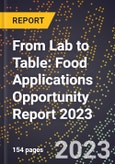Analytical instrumentation plays a critical role in food testing, enabling companies in the food industry to comply with modern-day food safety guidelines, standards, and laws while also ensuring consistency in food product quality. Therefore, it is imperative for food companies to have a well-established testing structure in place and adhere to increasingly stringent regulatory requirements that govern the entire food supply chain.
For most manufacturing facilities in the food industry, laboratories must first test the raw materials that are purchased from an external supplier or farm. This must occur before they are allowed to be processed by the manufacturer. As the raw materials are processed, they are usually tested or monitored in some way. Samples tested during this phase must either be taken directly from the production line and brought to a laboratory or assessed with in-line process analytical tools. When the final food product is ready, its physical, chemical, and microbiological characteristics are assessed in various ways.
During the COVID-19 pandemic, many consumers turned to pantry-loading as businesses shut down and remote work became the norm. However, this surge in demand resulted in supply chain disruptions as businesses struggled to keep up with maintaining supplies in the face of border closures, staffing challenges and social distancing measures. However, this surge in demand resulted in supply chain disruptions as businesses struggled to keep up with maintaining supplies in the face of border closures, staffing challenges, and social distancing measures. The war in Ukraine beginning in early 2022 has further aggravated supply chains, impacting food-related businesses and consumers alike as the country is a major producer of grain and cooking oil. The resulting imbalance between supply and demand has led to inflation, with food prices soaring by 9.9% from 2021 to 2022. Fortunately, food prices are expected to grow at a slower rate in 2023 compared to 2022, though it is still projected to remain above historical average rates, potentially affecting consumers’ shopping habits amid concerns of a recession and a slowing economy.
Despite ongoing shortages and changing spending habits, the demand for food testing remains strong. The scarcity of ingredients and packaging materials has compelled many companies to innovate and reformulate existing products to meet the increased demand. This has resulted in a robust demand for analytical instrumentation to facilitate testing and ensure compliance with safety guidelines and standards.
The 2023 Lab to Table Analytical Instrumentation Market report for food applications observes the dynamics and numerous market trends influencing the industry and analyzes their effect on sales growth for instruments used to test materials intended for consumption. As the leading provider of market research on analytical instrumentation, the analyst has crafted this report to evaluate and explain what is currently driving this important market. The analytical instrument market in this report includes laboratory benchtop, portable, and process-scale instruments utilized in food & beverage testing. These instruments are categorized into thirteen different technologies which build the overall market.
Report Overview:
Market demand is segmented by technique, region, and function, along with yearly market forecasts through 2027. The market estimates have been newly updated with 2022 as the base year and estimates are provided for the following techniques employed by the food & beverage industry:
1. Microbiology & Food Safety
2. Process Analytical Techniques
3. Chromatography
4. Molecular Spectroscopy
5. Sample preparation
6. Life Sciences
7. Mass Spectrometry
8. Surface Science
9. Electrochemistry
10. Lab Equipment
11. Materials Characterization
12. Lab Automation
13. Atomic Spectroscopy
Market opportunities and threats for food & beverage industry and regional trends for the United States & Canada, Europe, China, Japan, India & Other Asia-Pacific, Latin America & the Rest of the World.
Vendor share of participating suppliers in each technology category employed by the food & beverage industry. Some of the top vendors in the overall market are presented below, in alphabetical order:
- 3M
- A&D Weighing
- Agilent
- Avantor
- bioMérieux
- Bio-Rad
- Biotage
- CAMAG
- Charles River
- Danaher
- Foss
- HORIBA
- Mettler Toledo
- MilliporeSigma
- PerkinElmer
- QIAGEN
- Sartorius
- Shimadzu
- Thermo
- Waters
- ZEISS
Table of Contents
Companies Mentioned
- 3M
- A&D Weighing
- Agilent
- Avantor
- bioMérieux
- Bio-Rad
- Biotage
- CAMAG
- Charles River
- Danaher
- Foss
- HORIBA
- Mettler Toledo
- MilliporeSigma
- PerkinElmer
- QIAGEN
- Sartorius
- Shimadzu
- Thermo
- Waters
- ZEISS








